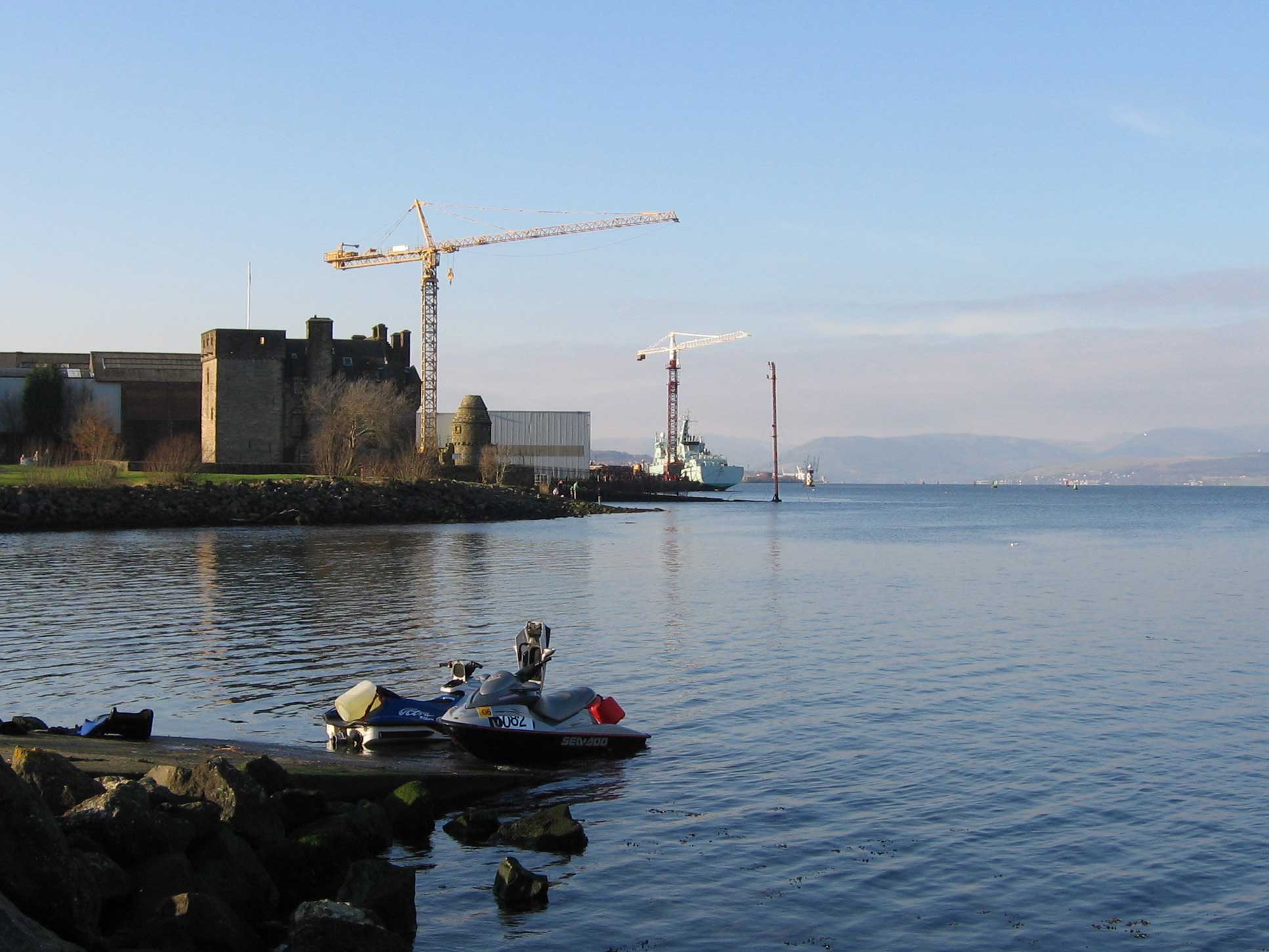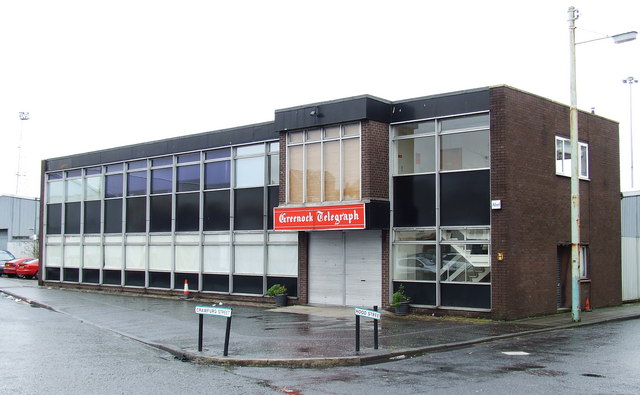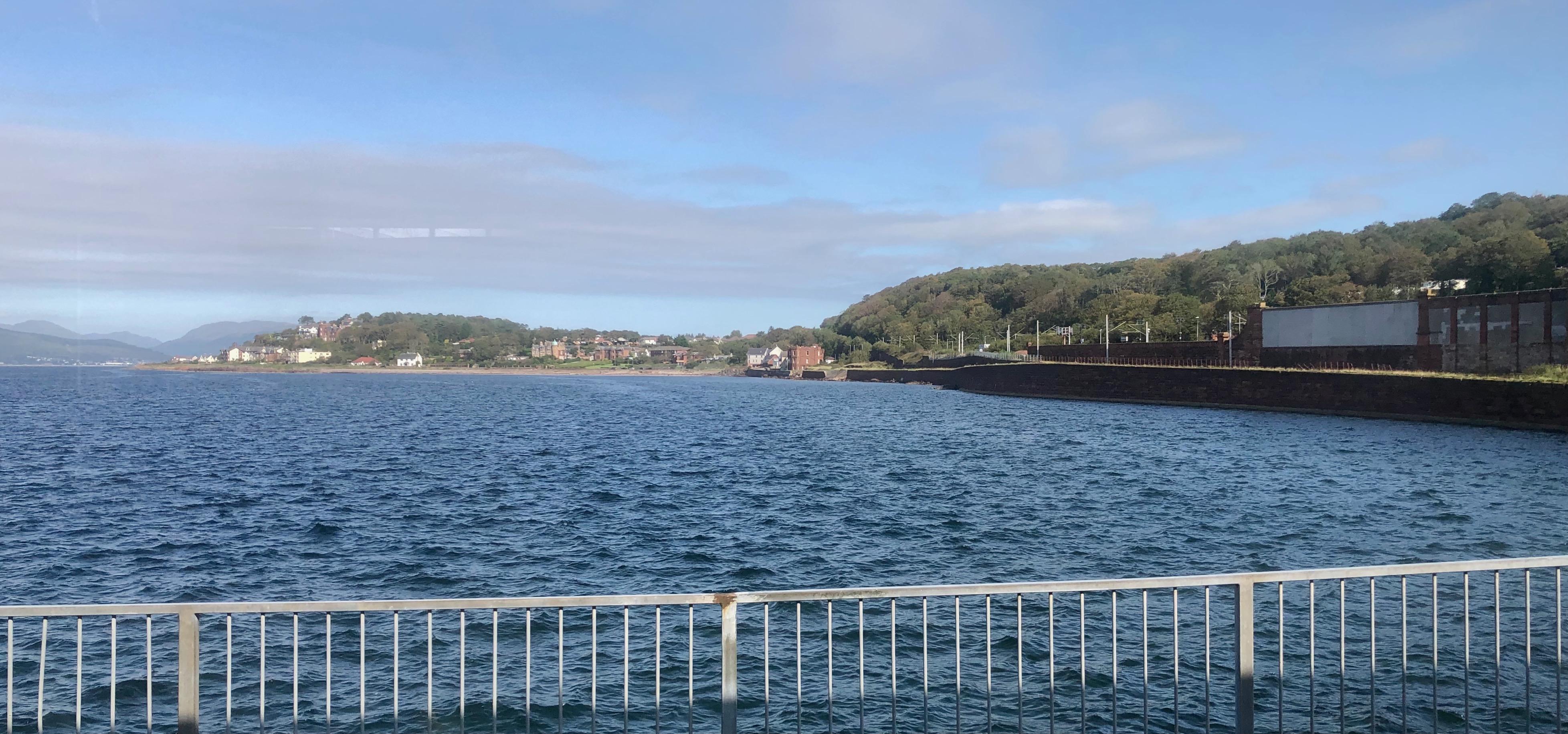|
Woodhall, Port Glasgow
Woodhall is a housing scheme in the lower east end of Port Glasgow, Inverclyde in Scotland. It stands on land once occupied by Woodhall mansion and estate. The mansion stood where St Martin's church now stands on Mansion Avenue. Woodhall is on a north facing slope, overlooking the River Clyde and is bounded on the north by the River Clyde, on the south by Parkhill Avenue, on the west by Port Glasgow cemetery and on the east by what is now the Castlebank housing estate which is on the site of the former Broadfield Hospital. History Built in the 1930s as the town expanded eastwards, Woodhall was a thriving community centred on Woodhall Square and the adjoining Woodhall Terrace at the foot of the hill. Mansion Avenue and Heggies Avenue climb up the steep hill to opposite ends of Parkhill Avenue, whilst Brightside, Pleasantside and Sunnyside Avenues (plus a branch of Mansion Avenue) follow the contours of the hill and are therefore reasonably flat. Woodhall Terrace consisted of fine ... [...More Info...] [...Related Items...] OR: [Wikipedia] [Google] [Baidu] |
Port Glasgow
Port Glasgow (, ) is the second-largest town in the Inverclyde council area of Scotland. The population according to the 1991 census for Port Glasgow was 19,426 persons and in the 2001 census was 16,617 persons. The most recent census in 2011 states that the population has declined to 15,414. It is located immediately to the east of Greenock and was previously a burgh in the county of Renfrewshire (historic), Renfrewshire. Originally a fishing hamlet named Newark, Port Glasgow came about as a result of large ships being unable to navigate the shallow and meandering River Clyde to the centre of the city of Glasgow. Because of this, it was formed as a remote port for Glasgow in 1668 and became known as 'New Port Glasgow', which was shortened to 'Port Glasgow' in 1775. Port Glasgow was home to dry docks and shipbuilding beginning in 1780. The town grew from the central area of the present town and thus many of the town's historic buildings and people are found here. Port Glasgow e ... [...More Info...] [...Related Items...] OR: [Wikipedia] [Google] [Baidu] |
Inverclyde
Inverclyde (, , , "mouth of the Clyde") is one of 32 council areas used for local government in Scotland. Together with the East Renfrewshire and Renfrewshire council areas, Inverclyde forms part of the historic county of Renfrewshire, which currently exists as a registration county and lieutenancy area. Inverclyde is located in the west central Lowlands. It borders the North Ayrshire and Renfrewshire council areas, and is otherwise surrounded by the Firth of Clyde. Inverclyde was formerly one of nineteen districts within Strathclyde Region, from 1975 until 1996. Prior to 1975, Inverclyde was governed as part of the local government county of Renfrewshire, comprising the burghs of Greenock, Port Glasgow and Gourock, and the former fifth district of the county. Its landward area is bordered by the Kelly, North and South Routen burns to the southwest (separating Wemyss Bay and Skelmorlie, North Ayrshire), part of the River Gryfe and the Finlaystone Burn to the south-east. ... [...More Info...] [...Related Items...] OR: [Wikipedia] [Google] [Baidu] |
Scotland
Scotland is a Countries of the United Kingdom, country that is part of the United Kingdom. It contains nearly one-third of the United Kingdom's land area, consisting of the northern part of the island of Great Britain and more than 790 adjacent Islands of Scotland, islands, principally in the archipelagos of the Hebrides and the Northern Isles. To the south-east, Scotland has its Anglo-Scottish border, only land border, which is long and shared with England; the country is surrounded by the Atlantic Ocean to the north and west, the North Sea to the north-east and east, and the Irish Sea to the south. The population in 2022 was 5,439,842. Edinburgh is the capital and Glasgow is the most populous of the cities of Scotland. The Kingdom of Scotland emerged as an independent sovereign state in the 9th century. In 1603, James VI succeeded to the thrones of Kingdom of England, England and Kingdom of Ireland, Ireland, forming a personal union of the Union of the Crowns, three kingdo ... [...More Info...] [...Related Items...] OR: [Wikipedia] [Google] [Baidu] |
River Clyde
The River Clyde (, ) is a river that flows into the Firth of Clyde, in the west of Scotland. It is the eighth-longest river in the United Kingdom, and the second longest in Scotland after the River Tay. It runs through the city of Glasgow. The River Clyde estuary has an upper tidal limit located at the tidal weir next to Glasgow Green#Tidal Weir, Glasgow Green. Historically, it was important to the British Empire because of its role in shipbuilding and trade. To the Roman Britain, Romans, it was , and in the early medieval Cumbric language, it was known as or . It was central to the Kingdom of Strathclyde (). Etymology The exact etymology of the river's name is unclear, though it is known that the name is ancient. In 50AD, the Egyptian mathematician, astronomer and geographer Ptolemy, Claudius Ptolemy wrote of the river as "Klōta", It was called or by the Celtic Britons, Britons and by the Romans. It is therefore likely that the name comes from a Celtic language—mos ... [...More Info...] [...Related Items...] OR: [Wikipedia] [Google] [Baidu] |
Park Farm, Port Glasgow
Park Farm is a housing scheme in the upper east area of Port Glasgow, Inverclyde, Scotland Scotland is a Countries of the United Kingdom, country that is part of the United Kingdom. It contains nearly one-third of the United Kingdom's land area, consisting of the northern part of the island of Great Britain and more than 790 adjac ..., built on the site of Park farm which stood near Parkhill Square. It consists of two distinct phases; the original phase stretches uphill from Parkhill Square to Mull Avenue and the second phase (Upper Park Farm) was built south of Mull Avenue in the late 1960s and consists of the streets around Oronsay Avenue. All of the streets take their names from Scottish islands. These include Stroma Avenue, Islay Avenue, Rona Avenue, Pladda Avenue, Westray Avenue, Sandray Avenue, Tiree Avenue, Staffa Avenue, Iona Road, Skye Road and Arran Avenue. File:Arran Avenue - geograph.org.uk - 843585.jpg, The foot of Arran Avenue File:Oronsay Avenue - geograph. ... [...More Info...] [...Related Items...] OR: [Wikipedia] [Google] [Baidu] |
Port Glasgow F
A port is a maritime facility comprising one or more wharves or loading areas, where ships load and discharge cargo and passengers. Although usually situated on a sea coast or estuary, ports can also be found far inland, such as Hamburg, Manchester and Duluth; these access the sea via rivers or canals. Because of their roles as ports of entry for immigrants as well as soldiers in wartime, many port cities have experienced dramatic multi-ethnic and multicultural changes throughout their histories. Ports are extremely important to the global economy; 70% of global merchandise trade by value passes through a port. For this reason, ports are also often densely populated settlements that provide the labor for processing and handling goods and related services for the ports. Today by far the greatest growth in port development is in Asia, the continent with some of the world's largest and busiest ports, such as Singapore and the Chinese ports of Shanghai and Ningbo-Zhoushan. As of 202 ... [...More Info...] [...Related Items...] OR: [Wikipedia] [Google] [Baidu] |
Greenock Telegraph
The ''Greenock Telegraph'' is a local daily newspaper serving Inverclyde (the council area containing the towns of Gourock, Greenock and Port Glasgow), Scotland. Founded in 1857, it was the first halfpenny daily newspaper in Britain. It was for a time ''Greenock Telegraph and Clyde Shipping Gazette'', owing to the massive amount of maritime traffic moving in and out of Greenock's harbours. This information is still published, but only as a column entry. Originally based in Charles Street, Greenock, the printing works were bombed during the Greenock Blitz in May 1941. However the printers worked on to produce emergency editions, despite sustaining multiple cuts from the shattered glass lodged in the presses. It is known locally as ''The Tele'' (although this is pronounced ''Tilly''). Several features such as ''Viator'' (Latin for ''traveller'') have formed part of the ''Telegraph'' for decades. Although it concerns itself primarily with news from Inverclyde, West Renfr ... [...More Info...] [...Related Items...] OR: [Wikipedia] [Google] [Baidu] |
Woodhall Railway Station
Woodhall railway station serves the eastern part of the town of Port Glasgow in Inverclyde, Scotland. The station is sited in the Woodhall area and is west of on the Inverclyde Line The Inverclyde Line is a railway line running from Glasgow Central station through Paisley (Gilmour Street) and a series of stations to the south of the River Clyde and the Firth of Clyde, terminating at Gourock and Wemyss Bay, where it conn .... Woodhall station is staffed only on Monday to Saturday in the daytime. Services As of March 2025, the typical off-peak daytime service in trains per hour (tph) is: * 2 tph to * 2 tph to Additional trains to call at the station during peak hours. During the evenings, all trains run to Gourock, with trains to Wemyss bay passing through without stopping. On Sundays, there is an hourly service between Glasgow Central and Gourock. Gallery File:Woodhall(2).jpg, Gourock bound train enters from the east. The ticket office, to the right of ... [...More Info...] [...Related Items...] OR: [Wikipedia] [Google] [Baidu] |
Inverclyde Line
The Inverclyde Line is a railway line running from Glasgow Central station through Paisley (Gilmour Street) and a series of stations to the south of the River Clyde and the Firth of Clyde, terminating at Gourock and Wemyss Bay, where it connects to Caledonian MacBrayne ferry services. The line has been in operation since the 1840s between Glasgow and Greenock and was the first passenger service to follow the River Clyde to the coast. The line was electrified in 1967. History The line was opened by the Glasgow, Paisley and Greenock Railway on 31 March 1841, and initially ran from Bridge Street railway station in Glasgow to a terminus at Cathcart Street, Greenock (later renamed Greenock Central railway station), with the section between Glasgow, and Paisley Gilmour Street being run by the Glasgow and Paisley Joint Railway. For the first time a railway took passengers right down the River Clyde, taking about one hour whereas Clyde steamers took around twice as long. The term ... [...More Info...] [...Related Items...] OR: [Wikipedia] [Google] [Baidu] |
Glasgow Central Railway Station
Glasgow Central (), usually referred to in Scotland as just Central or Central Station, is one of two principal mainline rail terminals in Glasgow, Scotland. The railway station was opened by the Caledonian Railway on 1 August 1879 and is one of 20 managed by Network Rail. It is the northern terminus of the West Coast Main Line ( north of Euston railway station, London Euston).Thomas (1971); Chapter VIII – Glasgow As well as being Glasgow's principal inter-city terminus for services to England, Central also serves the southern suburbs of the Greater Glasgow conurbation, as well as the Ayrshire and Clyde coasts. The other main station in Glasgow is , which primarily serves regional and intercity services to the north of Glasgow. The three letter station code is GLC. With 25 million passengers in 2023–2024, Glasgow Central is the List of busiest railway stations in Great Britain, fifteenth-busiest railway station in Britain and the busiest in Scotland, as well as the thi ... [...More Info...] [...Related Items...] OR: [Wikipedia] [Google] [Baidu] |
Gourock
Gourock ( ; ) is a town in the Inverclyde council areas of Scotland, council area and formerly a burgh of the County of Renfrew in the west of Scotland. It was a resort town, seaside resort on the East shore of the upper Firth of Clyde. Its main function today is as a residential area, extending contiguously from Greenock, with a railway terminus and ferry services across the Clyde. History The name Gourock comes from a Gaelic word for "pimple", in reference to the hill above the town. As far back as 1494 it is recorded that James IV of Scotland, James IV sailed from the shore at Gourock to quell the rebellious Highland clans. Two hundred years later William III of England, William and Mary granted a Charter in favour of Stewart of Castlemilk which raised Gourock to a Burgh of Barony. In 1784 the lands of Gourock were purchased by Duncan Darroch, a former merchant in Jamaica. He built Gourock House near the site of the castle in what the family eventually gifted to the town ... [...More Info...] [...Related Items...] OR: [Wikipedia] [Google] [Baidu] |
Wemyss Bay
Wemyss Bay () is a village on the coast of the Firth of Clyde in Inverclyde in the west central Lowlands of Scotland. It is in the traditional county of Renfrewshire (historic), Renfrewshire. It is adjacent to Skelmorlie, North Ayrshire. The town and villages have always been in separate counties, divided by the Kelly Burn. Wemyss Bay is the port for ferry, ferries on the Sea Road to Rothesay on the Isle of Bute. Passengers from the island can connect to Glasgow via Glasgow Central railway station by trains, which terminate in the town at Wemyss Bay railway station, noted for its architectural qualities and regarded as one of Scotland's finest railway buildings. The port is very exposed, so in high winds the ferries must travel up river to Gourock to dock. Topography Etymology The name Kelly comes from Celtic languages, with the meaning of a wood or woodland. Similarly, Kelburn Castle, Kelburn refers to a wooded river. The name Wemyss is derived from the Scottish Gaelic ''u ... [...More Info...] [...Related Items...] OR: [Wikipedia] [Google] [Baidu] |






